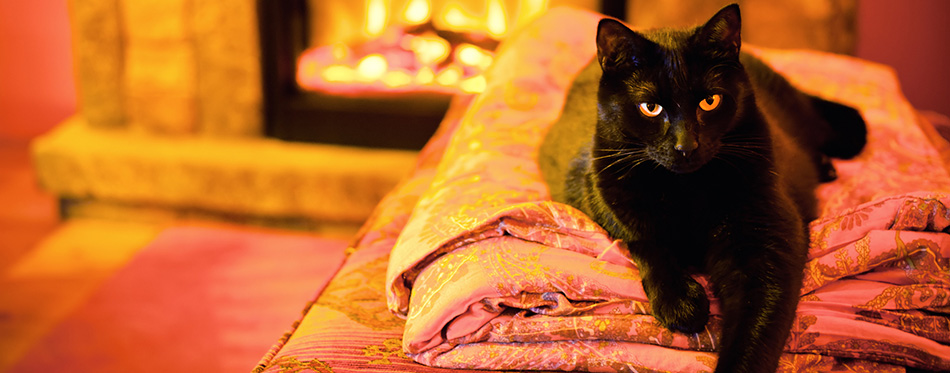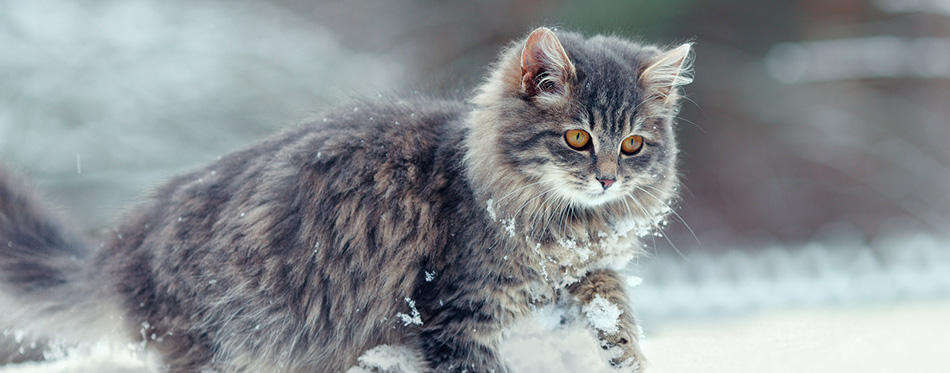Just like us, cats can also experience sluggishness and laziness during the winter months. It is not because of a behavioral problem in our kitties, but more because of seasonal changes. Winter means reduced sunlight and shorter days. These have an impact on a cat’s sleep-wake cycle, making it “less” active than during the warmer months. Cold weather also constricts the blood vessels, leading to a reduction in blood flow to the different organs including the brain. These processes can make a cat feel lazier and sleepier in the winter than in the summer. As cat parents, our job is to keep them active as a means of maintaining their optimal health. Here are 4 ways you can achieve that.

1. Make Meal and Treat Times Fun and Stimulating
One of the most important things we need to understand about winter is the sluggishness of a cat’s metabolism. This can increase its tendency to gain weight. If you already have a cat that has some serious issues, these can grow worse during the winter. As such, serving its meal in more stimulating and interesting ways will help prevent feline obesity in the winter. This will also give your cat more stable energy sources for it to stay active.
The shorter days of winter often means feeding cats a single meal every day. This is because people think that cats will be spending the rest of the day sleeping or lazing around. The problem with this approach is that cats are more prone to obesity as well as digestive issues. It takes a longer time for it to digest its food. This is often brought about by the reduction in blood flow associated with blood vessel constriction. The end result is that the cat will sleep longer through the rest of the day.
Giving your cat smaller yet more frequent feedings is the key to ensuring it receives all the nutrients it needs. This also allows it sufficient time to digest the nutrients in a more efficient manner. This also helps prevent the conversion of glucose molecules into fats and the latter’s eventual storage. In other words, feeding your cat more frequent yet smaller portions can help with its weight issues.
A more important effect of this is on the cat’s metabolism. Small frequent feedings foster more efficient metabolism. This allows the cat to engage in more meaningful activities as it has energy levels that are more sustained.
The question now is how do you administer these smaller yet more frequent feedings?
A good trick is to hide smaller portions of cat food in food bowls located around the house. You can also use feeding toys for such a purpose. The idea here is to stimulate the cat’s natural hunting instincts. In the wild, cats hunt for their next meal. In your house, you can mimic this setup.
As such, instead of offering your cat its next meal or treat on a silver platter, you might want to hide it. This works for cat foods that have appetizing aromas. This will stimulate your cat to go on a hunt.
2. Engage Your Cat in Meaningful Playtime
It is always best to engage your cat in more meaningful playtime. This is super easy since cats have very strong predatory instincts. This will help them move about in your house. They will no longer have to spend the rest of the day in their cat bed or cat house.
People have this idea that cats are lazy animals. The thing is that felines do not have an intense desire to build social relationships. This doesn’t mean they won’t appreciate good playtime. This is none truer than playtime that mimics the hunter-prey relationship.
There are different cat toys in the market that can help you engage your feline friend in a more physically-demanding activity. For instance, you can buy a pet-safe laser pointer to play with your cat. There are many videos online that showcase pet parents playing with their cats using laser light. Cats can run after and pounce on these red or green dots of light. You will also not get tired using a laser light. You can be sitting or lying on your couch waving your hand like crazy.
You can also get those fancy cat toys that look like fishing poles with lines on the end. Attached to this line is a feathery or plush toy that resembles a prey animal. It can be a bird or a rodent or anything else that can simulate a cat’s natural prey. Moving these cat toys about can mimic the action of a prey animal trying to evade a predator. Cats love the experience.
These playtime activities do more than keeping your cat active in the winter. It can help improve its mobility and agility which cats need in their predatory activities. Jumping, bouncing, and pouncing around your home can also help boost a cat’s metabolism. This can help the cat maintain a more ideal body weight and avoid potential complications.
You may not think that cats can get bored, but they do. Engaging them in meaningful playtime can prevent boredom. Playtime can also foster a healthier parent-cat relationship. This will draw you closer to your cat and your feline friend to you.
An hour of playtime every day should help your cat stay active during the winter.

3. Turn One of Your Rooms into a Cat Jungle
If you try to look at your house, you may notice that there aren’t any items that can stimulate your cat to be active. Sure, you may have a nice and cozy home complete with modern amenities. But your cat doesn’t see it that way. Your perception of your home is far different from the perception of your cat. So how do you change this?
It is critical to understand the unique predatory instincts of domestic cats. Even purebred cats will always have strong predatory instincts. They love to hunt. They are patient when it comes to stalking their prey. They love to move from one place to another, searching for the best location for hunting. They can lie in wait, ready to pounce when prey presents itself.
What we are saying is that you need to create a miniature hunting ground right inside your house. One of the best ways to do this is by getting a cat tree. These pieces of feline furniture feature multiple levels that come with different functions. There are those that come with a crow’s nest at the top which is the best place for your cat to wait for its prey. It offers an excellent vantage point for a cat to scan the “hunting grounds”.
There are also levels that come with cat toys dangling from a promontory. Cats can come down from their pedestal and play with these prey-like cat toys. There are scratching platforms, too. These can help cats become more active in the winter since scratching prepares them for their hunting activities.
If you can allot one small room for your cat, you can redesign it to include ladders and ramps that go around the room. You can also place different platforms on the walls of the room so your cat can go from one platform to the other. Your creativity and imagination are absolute musts for this endeavor.
You can also use a large cardboard box to turn into a miniature cat jungle. Punch holes through the sides and put different cat toys inside the box. Let your kitty explore the box and surprise it by sticking a finger into one of these holes. Be very fast, though. You don’t want your kitty biting your finger off. Remember, it will not know that it’s your finger wriggling through the hole. What it knows is that it could be prey.
4. Teach Your Cat Some Tricks
Some people think that cats are dumb. All they know is to sleep all day, waking up only to eat. This is not true. Cats are intelligent animals. The only problem is that some people don’t give them enough stimulation to harness their intellectual gifts.
Conventional cat toys can help your cat stay physically-active during the winter. But if you also teach it to perform some tricks, you are also stimulating its mental development.
You can also train your cat to obey simple commands following the same techniques employed in canine obedience training. Since cats are predators, their principal motivation is food. You can use your cat’s favorite cat food or cat treat as a reward for performing the tasks you want it to learn.
The most important part of feline training is the timing of the giving of the reward. The reward should come immediately after the desired action. This desired action should have a verbal cue to it so that your cat will associate the reward with the verbal cue.
Keeping your feline friend active during the winter entails a little creativity on your part. You can always capitalize on the cat’s predatory instincts to help it stay active all year round.
Sources:
- 10 tips to keep your cat happy indoors – Humane Society
- Keeping Your Cat Happy Indoors – Paws

